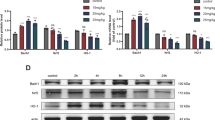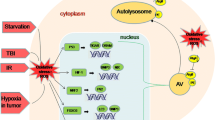Abstract
Oxidative stress-mediated neuron damage is considered an important contributor to the pathogenesis and development of neurodegenerative diseases. Although β-asarone is widely known for its neuroprotective pharmacological properties, the exact mechanism of β-asarone against oxidative stress has not been fully elucidated. The aim of the present study was to investigate underlying mechanisms of β-asarone against oxidative damage in PC12 cells. Our results demonstrated that the treatment of β-asarone significantly alleviated the reduction in cell viability and the excessive accumulation of lactate dehydrogenase (LDH), malondialdehyde (MDA) and reactive oxygen species (ROS) by increasing the activity of superoxide dismutase (SOD), catalase (CAT) and glutathione (GSH). Moreover, β-asarone pretreatment also activated nuclear factor 2 erythroid-related factor 2 (Nrf2) and its downstream target heme oxygenase-1 (HO-1), which was involved in quenching reactive oxygen to inhibit oxidative stress. Furthermore, when silenced by Nrf2 siRNA, the protective effect of β-asarone was reduced and the oxidative stress induced by H2O2 was enhanced. In conclusion, our findings revealed that β-asarone could reduce oxidative stress via activating Nrf2/HO-1 pathway in PC12 cells, highlighting the potential therapeutic role of β-asarone in neurodegenerative diseases.





Similar content being viewed by others
References
Chouhan AK, Guo C, Hsieh YC, Ye H, Senturk M, Zuo Z, Li Y, Chatterjee S, Botas J, Jackson GR, Bellen HJ, Shulman JM (2016) Uncoupling neuronal death and dysfunction in Drosophila models of neurodegenerative disease. Acta Neuropathol Commun 4:62. https://doi.org/10.1186/s40478-016-0333-4
Dugger BN, Dickson DW (2017) Pathology of neurodegenerative diseases. Cold Spring Harb Perspect Biol. https://doi.org/10.1101/cshperspect.a028035
Niedzielska E, Smaga I, Gawlik M, Moniczewski A, Stankowicz P, Pera J, Filip M (2016) Oxidative stress in neurodegenerative diseases. Neurobiology 53:4094–4125. https://doi.org/10.1007/s12035-015-9337-5
Liu M, Bai X, Yu S, Zhao W, Qiao J, Liu Y, Zhao D, Wang J, Wang S (2019) Ginsenoside re inhibits ROS/ASK-1 dependent mitochondrial apoptosis pathway and activation of Nrf2-antioxidant response in beta-amyloid-challenged SH-SY5Y cells. Molecules. https://doi.org/10.3390/molecules24152687
Kim JH, He MT, Kim MJ, Yang CY, Shin YS, Yokozawa T, Park CH, Cho EJ (2019) Safflower (Carthamus tinctorius L.) seed attenuates memory impairment induced by scopolamine in mice via regulation of cholinergic dysfunction and oxidative stress. Food Funct 10:3650–3659. https://doi.org/10.1039/c9fo00615j
Zhao X, Fang J, Li S, Gaur U, Xing X, Wang H, Zheng W (2019) Artemisinin attenuated hydrogen peroxide (H2O2)-induced oxidative injury in SH-SY5Y and hippocampal neurons via the activation of AMPK pathway. Int J Mol Sci. https://doi.org/10.3390/ijms20112680
Chellian R, Pandy V, Mohamed Z (2017) Pharmacology and toxicology of alpha- and beta-asarone: a review of preclinical evidence. Phytomedicine 32:41–58. https://doi.org/10.1016/j.phymed.2017.04.003
Yang QQ, Xue WZ, Zou RX, Xu Y, Du Y, Wang S, Xu L, Chen YZ, Wang HL, Chen XT (2016) beta-Asarone rescues Pb-induced impairments of spatial memory and synaptogenesis in rats. PLoS ONE 11:e167401. https://doi.org/10.1371/journal.pone.0167401
Wu HB, Fang YQ (2004) Pharmacokinetics of beta-asarone in rats. Yao Xue Xue Bao 39:836–838
Parki A, Chaubey P, Prakash O, Kumar R, Pant AK (2017) Seasonal variation in essential oil compositions and antioxidant properties of Acorus calamus L. Access Med (Basel). https://doi.org/10.3390/medicines4040081
Xiao X, Xu X, Li F, Xie G, Zhang T (2019) Anti-inflammatory treatment with beta-asarone improves impairments in social interaction and cognition in MK-801 treated mice. Brain Res Bull 150:150–159. https://doi.org/10.1016/j.brainresbull.2019.05.017
Li L, Yang Y, Wu M, Yu Z, Wang C, Dou G, He H, Wang H, Yang N, Qi H, Xu X (2018) beta-Asarone induces apoptosis and cell cycle arrest of human glioma U251 cells via suppression of HnRNP A2/B1-mediated pathway in vitro and in vivo. Molecules. https://doi.org/10.3390/molecules23051072
Lee B, Sur B, Cho SG, Yeom M, Shim I, Lee H, Hahm DH (2015) Effect of beta-asarone on impairment of spatial working memory and apoptosis in the hippocampus of rats exposed to chronic corticosterone administration. Biomol Ther (Seoul) 23:571–581. https://doi.org/10.4062/biomolther.2015.027
Deng M, Huang L, Ning B, Wang N, Zhang Q, Zhu C, Fang Y (2016) beta-Asarone improves learning and memory and reduces acetyl cholinesterase and beta-amyloid 42 levels in APP/PS1 transgenic mice by regulating Beclin-1-dependent autophagy. Brain Res 1652:188–194. https://doi.org/10.1016/j.brainres.2016.10.008
Loboda A, Damulewicz M, Pyza E, Jozkowicz A, Dulak J (2016) Role of Nrf2/HO-1 system in development, oxidative stress response and diseases: an evolutionarily conserved mechanism. Cell Mol Life Sci 73:3221–3247. https://doi.org/10.1007/s00018-016-2223-0
Taguchi K, Yamamoto M (2017) The KEAP1-NRF2 system in cancer. Front Oncol 7:85. https://doi.org/10.3389/fonc.2017.00085
Buendia I, Michalska P, Navarro E, Gameiro I, Egea J, Leon R (2016) Nrf2-ARE pathway: an emerging target against oxidative stress and neuroinflammation in neurodegenerative diseases. Pharmacol Ther 157:84–104. https://doi.org/10.1016/j.pharmthera.2015.11.003
Huang Y, Li W, Su ZY, Kong AN (2015) The complexity of the Nrf2 pathway: beyond the antioxidant response. J Nutr Biochem 26:1401–1413. https://doi.org/10.1016/j.jnutbio.2015.08.001
Niture SK, Khatri R, Jaiswal AK (2014) Regulation of Nrf2-an update. Free Radic Biol Med 66:36–44. https://doi.org/10.1016/j.freeradbiomed.2013.02.008
Chen QM, Maltagliati AJ (2018) Nrf2 at the heart of oxidative stress and cardiac protection. Physiol Genom 50:77–97. https://doi.org/10.1152/physiolgenomics.00041.2017
Deng Z, Lim J, Wang Q, Purtell K, Wu S, Palomo GM, Tan H, Manfredi G, Zhao Y, Peng J, Hu B, Chen S, Yue Z (2019) ALS-FTLD-linked mutations of SQSTM1/p62 disrupt selective autophagy and NFE2L2/NRF2 anti-oxidative stress pathway. Autophagy. https://doi.org/10.1080/15548627.2019.1644076
Hernando S, Requejo C, Herran E, Ruiz-Ortega JA, Morera-Herreras T, Lafuente JV, Ugedo L, Gainza E, Pedraz JL, Igartua M, Hernandez RM (2019) Beneficial effects of n-3 polyunsaturated fatty acids administration in a partial lesion model of Parkinson's disease: the role of glia and NRf2 regulation. Neurobiol Dis 121:252–262. https://doi.org/10.1016/j.nbd.2018.10.001
Izquierdo V, Palomera-Avalos V, Lopez-Ruiz S, Canudas AM, Pallas M, Grinan-Ferre C (2019) Maternal resveratrol supplementation prevents cognitive decline in senescent mice offspring. Int J Mol Sci. https://doi.org/10.3390/ijms20051134
Liu J, Tan F, Liu X, Yi R, Zhao X (2019) Exploring the antioxidant effects and periodic regulation of cancer cells by polyphenols produced by the fermentation of grape skin by Lactobacillus plantarum KFY02. Biomolecules. https://doi.org/10.3390/biom9100575
Ning B, Zhang Q, Wang N, Deng M, Fang Y (2019) beta-Asarone regulates ER stress and autophagy via inhibition of the PERK/CHOP/Bcl-2/Beclin-1 pathway in 6-OHDA-induced Parkinsonian rats. Neurochem Res 44:1159–1166. https://doi.org/10.1007/s11064-019-02757-w
Li Z, Zhao G, Qian S, Yang Z, Chen X, Chen J, Cai C, Liang X, Guo J (2012) Cerebrovascular protection of beta-asarone in Alzheimer's disease rats: a behavioral, cerebral blood flow, biochemical and genic study. J Ethnopharmacol 144:305–312. https://doi.org/10.1016/j.jep.2012.09.013
Zhang QS, Wang ZH, Zhang JL, Duan YL, Li GF, Zheng DL (2016) Beta-asarone protects against MPTP-induced Parkinson's disease via regulating long non-coding RNA MALAT1 and inhibiting alpha-synuclein protein expression. Biomed Pharmacother 83:153–159. https://doi.org/10.1016/j.biopha.2016.06.017
Chang W, Teng J (2018) Combined application of tenuigenin and beta-asarone improved the efficacy of memantine in treating moderate-to-severe Alzheimer's disease. Drug Des Devel Ther 12:455–462. https://doi.org/10.2147/DDDT.S155567
Bhat AH, Dar KB, Anees S, Zargar MA, Masood A, Sofi MA, Ganie SA (2015) Oxidative stress, mitochondrial dysfunction and neurodegenerative diseases: a mechanistic insight. Biomed Pharmacother 74:101–110. https://doi.org/10.1016/j.biopha.2015.07.025
Carvalho AN, Firuzi O, Gama MJ, Horssen JV, Saso L (2017) Oxidative stress and antioxidants in neurological diseases: is there still hope? Curr Drug Targets 18:705–718. https://doi.org/10.2174/1389450117666160401120514
Thanan R, Oikawa S, Hiraku Y, Ohnishi S, Ma N, Pinlaor S, Yongvanit P, Kawanishi S, Murata M (2014) Oxidative stress and its significant roles in neurodegenerative diseases and cancer. Int J Mol Sci 16:193–217. https://doi.org/10.3390/ijms16010193
Wadhwa R, Gupta R, Maurya PK (2018) Oxidative stress and accelerated aging in neurodegenerative and neuropsychiatric disorder. Curr Pharm Des 24:4711–4725. https://doi.org/10.2174/1381612825666190115121018
Liu FW, Liu FC, Wang YR, Tsai HI, Yu HP (2015) Aloin protects skin fibroblasts from heat stress-induced oxidative stress damage by regulating the oxidative defense system. PLoS ONE 10:e143528. https://doi.org/10.1371/journal.pone.0143528
Sun H, Zhu J, Lin H, Gu K, Feng F (2017) Recent progress in the development of small molecule Nrf2 modulators: a patent review (2012–2016). Exp Opin Ther Patents 27:763–785. https://doi.org/10.1080/13543776.2017.1325464
Deck LM, Whalen LJ, Hunsaker LA, Royer RE, Vander JD (2017) Activation of anti-oxidant Nrf2 signaling by substituted trans stilbenes. Bioorg Med Chem 25:1423–1430. https://doi.org/10.1016/j.bmc.2017.01.005
Mattioli R, Francioso A, D'Erme M, Trovato M, Mancini P, Piacentini L, Casale AM, Wessjohann L, Gazzino R, Costantino P, Mosca L (2019) Anti-inflammatory activity of a polyphenolic extract from Arabidopsis thaliana in in vitro and in vivo models of Alzheimer's disease. Int J Mol Sci. https://doi.org/10.3390/ijms20030708
Liu S, Li G, Tang H, Pan R, Wang H, Jin F, Yan X, Xing Y, Chen G, Fu Y, Dong J (2019) Madecassoside ameliorates lipopolysaccharide-induced neurotoxicity in rats by activating the Nrf2-HO-1 pathway. Neurosci Lett 709:134386. https://doi.org/10.1016/j.neulet.2019.134386
Ikram M, Saeed K, Khan A, Muhammad T, Khan MS, Jo MG, Rehman SU, Kim MO (2019) Natural dietary supplementation of curcumin protects mice brains against ethanol-induced oxidative stress-mediated neurodegeneration and memory impairment via Nrf2/TLR4/RAGE signaling. Nutrients. https://doi.org/10.3390/nu11051082
Jang M, Choi JH, Chang Y, Lee SJ, Nah SY, Cho IH (2019) Gintonin, a ginseng-derived ingredient, as a novel therapeutic strategy for Huntington's disease: activation of the Nrf2 pathway through lysophosphatidic acid receptors. Brain Behav Immun 80:146–162. https://doi.org/10.1016/j.bbi.2019.03.001
Jin Y, Tao X, Shi Y, Lu Y, Mei J (2019) Salvianolic acid B exerts a protective effect in acute liver injury by regulating the Nrf2/HO-1 signaling pathway. Can J Physiol Pharmacol. https://doi.org/10.1139/cjpp-2019-0349
Acknowledgements
This research was supported by the Natural Science Foundation of China (No. 81173313) and Postgraduate Research & Practice Innovation Program of Jiangsu Province (CN) (SJKY19_1434).
Author information
Authors and Affiliations
Corresponding author
Ethics declarations
Conflict of interest
The authors declare no conflicts of interest to disclose.
Additional information
Publisher's Note
Springer Nature remains neutral with regard to jurisdictional claims in published maps and institutional affiliations.
Rights and permissions
About this article
Cite this article
Hei, X., Xie, M., Xu, J. et al. β-Asarone Exerts Antioxidative Effects on H2O2-Stimulated PC12 Cells by Activating Nrf2/HO-1 Pathway. Neurochem Res 45, 1953–1961 (2020). https://doi.org/10.1007/s11064-020-03060-9
Received:
Revised:
Accepted:
Published:
Issue Date:
DOI: https://doi.org/10.1007/s11064-020-03060-9




